
Archive
| Book Alert, November - December 2015 |
| 1. 2014 Nationalism and national security in India / G D Bakshi - New Delhi: KW Publishers, 2015 |
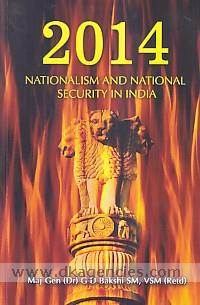 Abstract: 2014 was a critical year that saw the revival of Nationalism in India. This book examines Indian Nationalism and takes a close look at India's National Security. It revisits the somber truth about our freedom struggle. This book uses the technique of Pattern Modeling to study India's recent history and make forecasts about its collective future. Patterns tend to persist and repeat themselves cyclically. Hence, they become the basis for Heuristic forecasts about the future. This book, therefore, is in two parts. Part one takes an analytical look at our last 70-80 years to identify the patterns. Book two then uses this pattern analysis to make forecasts about our near term future in terms of a Net Assessment that uses the tools of Trends, Drivers and Discontinuities to create a set of Alternative Futures. Abstract: 2014 was a critical year that saw the revival of Nationalism in India. This book examines Indian Nationalism and takes a close look at India's National Security. It revisits the somber truth about our freedom struggle. This book uses the technique of Pattern Modeling to study India's recent history and make forecasts about its collective future. Patterns tend to persist and repeat themselves cyclically. Hence, they become the basis for Heuristic forecasts about the future. This book, therefore, is in two parts. Part one takes an analytical look at our last 70-80 years to identify the patterns. Book two then uses this pattern analysis to make forecasts about our near term future in terms of a Net Assessment that uses the tools of Trends, Drivers and Discontinuities to create a set of Alternative Futures. |
| 2. The 3rd ASEAN reader / Ooi Kee Beng - Singapore: ISEAS, 2015 |
 Abstract: Over the past two decades, ISEAS has compiled abridged articles that analyse key aspects of Southeast Asia's development and the ASEAN process. The ASEAN Reader was published in 1992 just as the Cold War ended, while The Second ASEAN Reader came in 2003 in the wake of the 1997 Asian crisis and the September 11 attacks in 2001. The past decade has not been spared its share of intense changes, with the rise of China and India bringing new challenges to the region's power equation, and the impact of the 2008 global financial crisis. Despite this, the momentum towards an integrated ASEAN community has been maintained. The articles in The Third ASEAN Reader study the trends and events of recent years, and discuss the immediate future of Southeast Asia. Abstract: Over the past two decades, ISEAS has compiled abridged articles that analyse key aspects of Southeast Asia's development and the ASEAN process. The ASEAN Reader was published in 1992 just as the Cold War ended, while The Second ASEAN Reader came in 2003 in the wake of the 1997 Asian crisis and the September 11 attacks in 2001. The past decade has not been spared its share of intense changes, with the rise of China and India bringing new challenges to the region's power equation, and the impact of the 2008 global financial crisis. Despite this, the momentum towards an integrated ASEAN community has been maintained. The articles in The Third ASEAN Reader study the trends and events of recent years, and discuss the immediate future of Southeast Asia. |
| 3. Accounting for carbon: monitoring, reporting and verifying emissions in the climate economy / Edited by Valentin Bellassen and Nicolas Stephan - Cambridge: Cambridge University Press, 2015 |
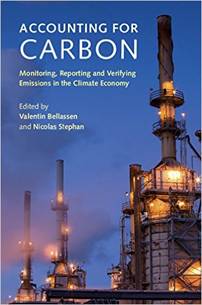 Abstract: The ability to accurately monitor, record, report and verify greenhouse gas emissions is the cornerstone of any effective policy to mitigate climate change. Accounting for Carbon provides the first authoritative overview of the monitoring, reporting and verification (MRV) of emissions from the industrial site, project and company level to the regional and national level. It describes the MRV procedures in place in more than fifteen of the most important policy frameworks - such as emissions trading systems in Europe, Australia, California and China, and the United Nations Framework Convention on Climate Change - and compares them along key criteria such as scope, cost, uncertainty and flexibility. This book draws on the work of engineers and economists to provide a practical guide to help government and non-governmental policy makers and key stakeholders in industry to better understand different MRV requirements, the key trade-offs faced by regulators and the choices made by up-and-running carbon pricing initiatives. Abstract: The ability to accurately monitor, record, report and verify greenhouse gas emissions is the cornerstone of any effective policy to mitigate climate change. Accounting for Carbon provides the first authoritative overview of the monitoring, reporting and verification (MRV) of emissions from the industrial site, project and company level to the regional and national level. It describes the MRV procedures in place in more than fifteen of the most important policy frameworks - such as emissions trading systems in Europe, Australia, California and China, and the United Nations Framework Convention on Climate Change - and compares them along key criteria such as scope, cost, uncertainty and flexibility. This book draws on the work of engineers and economists to provide a practical guide to help government and non-governmental policy makers and key stakeholders in industry to better understand different MRV requirements, the key trade-offs faced by regulators and the choices made by up-and-running carbon pricing initiatives. |
| 4. Adaptation to climate change: ASEAN and comparative experiences / Edited by Koh Kheng-Lian - London: World Scientific, 2016 |
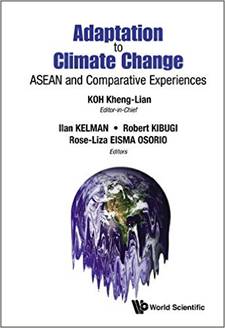 Abstract: Adaptation to Climate Change: ASEAN and Comparative Experiences presents a dynamic and comprehensive collection of works from legal scholars around the world that delves into a relatively new frontier on legal aspects of climate change adaptation with focus on the ASEAN region, both at the regional level as well as at the national level in some ASEAN countries — such as Malaysia, Philippines, and Thailand. Other countries not within ASEAN are also represented, such as Bangladesh, People's Republic of China, Sri Lanka, and the Republic of Taiwan. In doing so, it surveys one of the most important issues confronting developing countries today, and the challenges to building resilient societies. It is an essential source of reference for policy-makers, administrators, the private sector officials, scientists, academic scholars, climatologists, NGOs, and CSOs in ASEAN and the world. Abstract: Adaptation to Climate Change: ASEAN and Comparative Experiences presents a dynamic and comprehensive collection of works from legal scholars around the world that delves into a relatively new frontier on legal aspects of climate change adaptation with focus on the ASEAN region, both at the regional level as well as at the national level in some ASEAN countries — such as Malaysia, Philippines, and Thailand. Other countries not within ASEAN are also represented, such as Bangladesh, People's Republic of China, Sri Lanka, and the Republic of Taiwan. In doing so, it surveys one of the most important issues confronting developing countries today, and the challenges to building resilient societies. It is an essential source of reference for policy-makers, administrators, the private sector officials, scientists, academic scholars, climatologists, NGOs, and CSOs in ASEAN and the world. |
| 5. The Agendas of Tibetan refugees: surivival, strategies of a government-in-exile in a world of transnational organization / Thomas Kauffmann - New York: Berghahn, 2015 |
 Abstract: Since the arrival of the first Tibetans in exile in 1959, a vast and continuous wave of international - especially Western - support has permitted these refugees to survive and even to flourish in their temporary places of residence. Today, these Tibetan refugees continue to attract assistance from Western governments, organizations and individuals, while other refugee populations are largely forgotten in the international agenda. This book shows and discusses how Tibetan refugees continue to attract resources, due, notably, to the dissemination of their political and religious agendas, as well as how a movement of Western supporters, born in very different conditions, guaranteed a unique relationship with these refugees. Abstract: Since the arrival of the first Tibetans in exile in 1959, a vast and continuous wave of international - especially Western - support has permitted these refugees to survive and even to flourish in their temporary places of residence. Today, these Tibetan refugees continue to attract assistance from Western governments, organizations and individuals, while other refugee populations are largely forgotten in the international agenda. This book shows and discusses how Tibetan refugees continue to attract resources, due, notably, to the dissemination of their political and religious agendas, as well as how a movement of Western supporters, born in very different conditions, guaranteed a unique relationship with these refugees. |
| 6. The Ahmadis and the politics of religious exclusion in Pakistan / Ali Usman Qasmi - London: Anthem Press, 2015 |
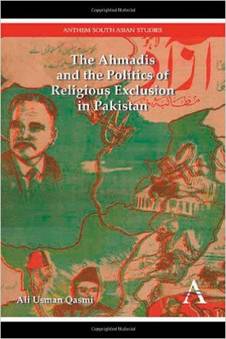 Abstract: In this path-breaking new work, Ali Usman Qasmi traces the history of the political exclusion of the Ahmadiyya religious minority in Pakistan by drawing on revealing new sources. This volume is the first scholarly study of the declassified material of the court of inquiry that produced the Munir–Kiyani report of 1954, and the proceedings of the national assembly that declared the Ahmadis non-Muslims through the second constitutional amendment in 1974. The Ahmadis and the Politics of Religious Exclusion in Pakistan chronicles anti-Ahmadi violence and the legal and administrative measures adopted against them, and also address wider issues of the politics of Islam in postcolonial Muslim nation-states and their disputative engagements with ideas of modernity and citizenship. Abstract: In this path-breaking new work, Ali Usman Qasmi traces the history of the political exclusion of the Ahmadiyya religious minority in Pakistan by drawing on revealing new sources. This volume is the first scholarly study of the declassified material of the court of inquiry that produced the Munir–Kiyani report of 1954, and the proceedings of the national assembly that declared the Ahmadis non-Muslims through the second constitutional amendment in 1974. The Ahmadis and the Politics of Religious Exclusion in Pakistan chronicles anti-Ahmadi violence and the legal and administrative measures adopted against them, and also address wider issues of the politics of Islam in postcolonial Muslim nation-states and their disputative engagements with ideas of modernity and citizenship. |
| 7. Al Qaeda, the Islamic state, and the global Jihadist movement: what everyone needs to know / Daniel Byman - New York: Oxford University Press, 2015 |
 Abstract: On the morning of September 11, 2001, the entire world was introduced to Al Qaeda and its enigmatic leader, Osama bin Laden. But the organization that changed the face of terrorism forever and unleashed a whirlwind of counterterrorism activity and two major wars had been on the scene long before that eventful morning. In Al Qaeda, the Islamic State, and the Global Jihadist Movement: What Everyone Needs to Know, Daniel L. Byman, an eminent scholar of Middle East terrorism and international security who served on the 9/11 Commission, provides a sharp and concise overview of Al Qaeda, from its humble origins in the mountains of Afghanistan to the present, explaining its perseverance and adaptation since 9/11 and the limits of U.S. and allied counterterrorism efforts. Abstract: On the morning of September 11, 2001, the entire world was introduced to Al Qaeda and its enigmatic leader, Osama bin Laden. But the organization that changed the face of terrorism forever and unleashed a whirlwind of counterterrorism activity and two major wars had been on the scene long before that eventful morning. In Al Qaeda, the Islamic State, and the Global Jihadist Movement: What Everyone Needs to Know, Daniel L. Byman, an eminent scholar of Middle East terrorism and international security who served on the 9/11 Commission, provides a sharp and concise overview of Al Qaeda, from its humble origins in the mountains of Afghanistan to the present, explaining its perseverance and adaptation since 9/11 and the limits of U.S. and allied counterterrorism efforts. |
| 8. Al Qaeda: the transformation of terrorism in the middle east and North Africa / Denise N Baken and Ioannis Mantzikos - California: Praeger, 2015 |
 Abstract: What threat does Al Qaeda pose to the United States as it continues to evolve in the wake of the Arab Spring, and what are the group's evolving strategies for growth and survival internationally? This book provides answers. Analyzes the Al Qaeda belief that violence is required to achieve its goals and the common Al Qaeda perception that violence was used effectively by the colonialists and the West, particularly the United States and France Identifies the precursors to Al Qaeda organizations and how al Qaeda became what it is today Examines Al Qaeda's business associations and its ties to piracy and organized crime, identifying the opportunities these ties create; as well as the organization's use of emerging technology-especially the Internet-to reach out to a younger, technology-savvy audience for their message. Abstract: What threat does Al Qaeda pose to the United States as it continues to evolve in the wake of the Arab Spring, and what are the group's evolving strategies for growth and survival internationally? This book provides answers. Analyzes the Al Qaeda belief that violence is required to achieve its goals and the common Al Qaeda perception that violence was used effectively by the colonialists and the West, particularly the United States and France Identifies the precursors to Al Qaeda organizations and how al Qaeda became what it is today Examines Al Qaeda's business associations and its ties to piracy and organized crime, identifying the opportunities these ties create; as well as the organization's use of emerging technology-especially the Internet-to reach out to a younger, technology-savvy audience for their message. |
| 9. The Arab-Israeli conflict / T.G. Fraser - 14th Ed - New York: Palgrave Macmillan, 2015 |
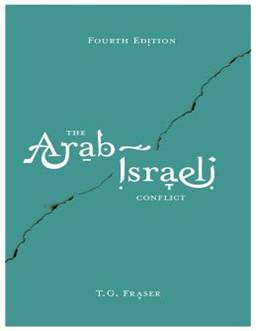 Abstract: T. G. Fraser provides a balanced and thoughtful analysis of one of the most tragic conflicts in modern history. From the creation of Israel to the situation today, this text follows the key events and issues arising from the partition of Palestine. The major regional wars and Palestinian Intifadas are examined, with a particular focus on the series of crises over Gaza. This thoroughly updated edition features a new final chapter, covering events since 2007. It takes into account attempts by the USA to work towards a peace settlement, including John Kerry's initiative of 2013-14. These much-needed additions ensure that The Arab-Israeli Conflict remains an invaluable guide for students of the Middle East. Abstract: T. G. Fraser provides a balanced and thoughtful analysis of one of the most tragic conflicts in modern history. From the creation of Israel to the situation today, this text follows the key events and issues arising from the partition of Palestine. The major regional wars and Palestinian Intifadas are examined, with a particular focus on the series of crises over Gaza. This thoroughly updated edition features a new final chapter, covering events since 2007. It takes into account attempts by the USA to work towards a peace settlement, including John Kerry's initiative of 2013-14. These much-needed additions ensure that The Arab-Israeli Conflict remains an invaluable guide for students of the Middle East. |
| 10. The Arabs at war in Afghanistan / Mustafa Hamid and Leah Farrall - London: Hurst & Company, 2015 |
 Abstract: A former senior mujahidin figure and an ex-counter-terrorism analyst cooperating to write a book on the history and legacy of Arab-Afghan fighters in Afghanistan is a remarkable and improbable undertaking. Yet this is what Mustafa Hamid, aka Abu Walid al-Masri, and Leah Farrall have achieved with the publication of their ground-breaking work.The result of thousands of hours of discussions over several years, The Arabs at War in Afghanistan offers significant new insights into the history of many of todays militant Salafi groups and movements. By revealing the real origins of the Taliban and al-Qaeda and the jostling among the various jihadi groups, this account not only challenges conventional wisdom, but also raises uncomfortable questions as to how events from this important period have been so badly misconstrued. Abstract: A former senior mujahidin figure and an ex-counter-terrorism analyst cooperating to write a book on the history and legacy of Arab-Afghan fighters in Afghanistan is a remarkable and improbable undertaking. Yet this is what Mustafa Hamid, aka Abu Walid al-Masri, and Leah Farrall have achieved with the publication of their ground-breaking work.The result of thousands of hours of discussions over several years, The Arabs at War in Afghanistan offers significant new insights into the history of many of todays militant Salafi groups and movements. By revealing the real origins of the Taliban and al-Qaeda and the jostling among the various jihadi groups, this account not only challenges conventional wisdom, but also raises uncomfortable questions as to how events from this important period have been so badly misconstrued. |
| 11. Asia's new battlefield: the USA, China and the struggle for the western pacific / Richard Javad Heydarian - London: Zed Books, 2015 |
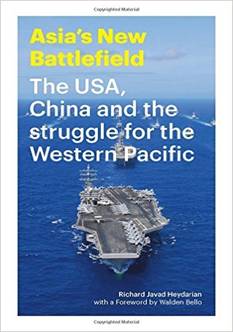 Abstract: For most of the decades since World War II, the Philippines has rested comfortably on the United States when it comes to military, security, and foreign policy questions. But the rapid rise of China as a regional economic and military power has complicated the situation dramatically and the Philippines is now forced to confront rising tensions and navigate a landscape that is suddenly more complicated. This compact, insightful book offers an up-to-the-minute guide to understanding the evolution of foreign policy both within and towards the Philippines in recent decades, and it traces the ways the state has sought to defend its territorial integrity amid the jockeying for position by the United States, China, and Japan. A provocative analysis that points to future power shifts that will have global resonance, Asia's New Battlefield will be crucial for both scholars and policy makers. Abstract: For most of the decades since World War II, the Philippines has rested comfortably on the United States when it comes to military, security, and foreign policy questions. But the rapid rise of China as a regional economic and military power has complicated the situation dramatically and the Philippines is now forced to confront rising tensions and navigate a landscape that is suddenly more complicated. This compact, insightful book offers an up-to-the-minute guide to understanding the evolution of foreign policy both within and towards the Philippines in recent decades, and it traces the ways the state has sought to defend its territorial integrity amid the jockeying for position by the United States, China, and Japan. A provocative analysis that points to future power shifts that will have global resonance, Asia's New Battlefield will be crucial for both scholars and policy makers. |
| 12. Assessing china's power / Edited by Jae Ho Chung - New York: Palgrave Macmillan, 2015 |
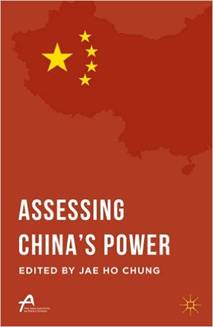 Abstract: The topic of China's rise and what it really means for the global and regional order is the subject of intense debate. In this volume, top scholars address China's power today, compare China's power with that of the USA, and forecast China's power in 2025. Abstract: The topic of China's rise and what it really means for the global and regional order is the subject of intense debate. In this volume, top scholars address China's power today, compare China's power with that of the USA, and forecast China's power in 2025. |
| 13. Assessing maritime power in the Asia-pacific: the impact of American strategic re-balances / Edited by Greg Kennedy and Harsh V. Pant - Engalnd: Ashgate, 2015 |
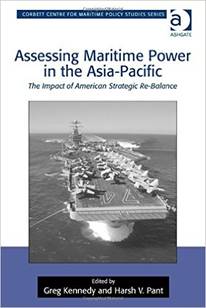 Abstract: Leading academics from around the world, who specialize in analysing maritime strategic issues, deliberate the impact of the American 'pivot' or 're-balance' strategy, and the 'Air-Sea Battle' operational concept, on the maritime power and posture of a number of selected states. Intending to strengthen US economic, diplomatic, and security engagement throughout the Asia-Pacific, both bilaterally and multilaterally, the re-balance stands out as one of the Obama administration's most far-sighted and ambitious foreign policy initiatives. Abstract: Leading academics from around the world, who specialize in analysing maritime strategic issues, deliberate the impact of the American 'pivot' or 're-balance' strategy, and the 'Air-Sea Battle' operational concept, on the maritime power and posture of a number of selected states. Intending to strengthen US economic, diplomatic, and security engagement throughout the Asia-Pacific, both bilaterally and multilaterally, the re-balance stands out as one of the Obama administration's most far-sighted and ambitious foreign policy initiatives. |
| 14. Ballots, bullets, and bargains: American Foreign policy and Presidential elections / Michael H. Armacost - New York: Columbia University Press, 2015 |
 Abstract: Drawing on twenty-four years of experience in government, Michael H. Armacost explores how the contours of the U.S. presidential election system influence the content and conduct of American foreign policy. He examines how the nomination battle impels candidates to express deference to the foreign policy DNA of their party and may force an incumbent to make wholesale policy adjustments to fend off an intra-party challenge for the nomination. He describes the way reelection campaigns can prod a chief executive to fix long-neglected problems, kick intractable policy dilemmas down the road, settle for modest course corrections, or scapegoat others for policies gone awry. Abstract: Drawing on twenty-four years of experience in government, Michael H. Armacost explores how the contours of the U.S. presidential election system influence the content and conduct of American foreign policy. He examines how the nomination battle impels candidates to express deference to the foreign policy DNA of their party and may force an incumbent to make wholesale policy adjustments to fend off an intra-party challenge for the nomination. He describes the way reelection campaigns can prod a chief executive to fix long-neglected problems, kick intractable policy dilemmas down the road, settle for modest course corrections, or scapegoat others for policies gone awry. |
| 15. Battle for hearts & minds: from north east to Kashmir and beyond / Dipak Mukherjee - New Delhi: Vitastaa, 2016 |
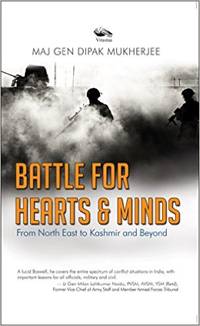 Abstract: Good governance is the greatest act of patriotism in 21st century in India, says Major General Dipak Mukherjee, in his book, Battle for Hearts & Minds from North East to Kashmir and Beyond.Just military intervention cannot compensate for governance deficit, argues Major General Dipak Mukherjee, sharing his unique insight into how the Indian Army actually won wars on the ground.When the moral compass was steady, as in Nagaland, in the 1950s and '60s or during the Bangladesh war of 1971, the Indian Army achieved victories far bigger than military surrenders. But in Sri Lanka, India's moral compass was severely tested. As one havildar said,'Sahib,we all are now in Sri Lanka. Last time in ancient history,Ram came here with his army to fight Raavan. Can you tell us, who is our Raavan here?' pleading for a larger perspective, the Major General says, the Battle for Hearts & Minds will continue to inform our understanding if wars. in this journey, Maj Gen Mukherjee's insights are a valuable milestone. Abstract: Good governance is the greatest act of patriotism in 21st century in India, says Major General Dipak Mukherjee, in his book, Battle for Hearts & Minds from North East to Kashmir and Beyond.Just military intervention cannot compensate for governance deficit, argues Major General Dipak Mukherjee, sharing his unique insight into how the Indian Army actually won wars on the ground.When the moral compass was steady, as in Nagaland, in the 1950s and '60s or during the Bangladesh war of 1971, the Indian Army achieved victories far bigger than military surrenders. But in Sri Lanka, India's moral compass was severely tested. As one havildar said,'Sahib,we all are now in Sri Lanka. Last time in ancient history,Ram came here with his army to fight Raavan. Can you tell us, who is our Raavan here?' pleading for a larger perspective, the Major General says, the Battle for Hearts & Minds will continue to inform our understanding if wars. in this journey, Maj Gen Mukherjee's insights are a valuable milestone. |
| 16. Between debt and the devil: money, credit, and fixing global finance / Adair Turner - Princeton: Princeton University Press, 2016 |
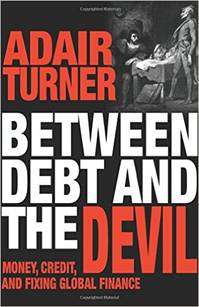 Abstract: Adair Turner became chairman of Britain's Financial Services Authority just as the global financial crisis struck in 2008, and he played a leading role in redesigning global financial regulation. In this eye-opening book, he sets the record straight about what really caused the crisis. It didn't happen because banks are too big to fail--our addiction to private debt is to blame. Between Debt and the Devil challenges the belief that we need credit growth to fuel economic growth, and that rising debt is okay as long as inflation remains low. In fact, most credit is not needed for economic growth--but it drives real estate booms and busts and leads to financial crisis and depression. Turner explains why public policy needs to manage the growth and allocation of credit creation, and why debt needs to be taxed as a form of economic pollution. Abstract: Adair Turner became chairman of Britain's Financial Services Authority just as the global financial crisis struck in 2008, and he played a leading role in redesigning global financial regulation. In this eye-opening book, he sets the record straight about what really caused the crisis. It didn't happen because banks are too big to fail--our addiction to private debt is to blame. Between Debt and the Devil challenges the belief that we need credit growth to fuel economic growth, and that rising debt is okay as long as inflation remains low. In fact, most credit is not needed for economic growth--but it drives real estate booms and busts and leads to financial crisis and depression. Turner explains why public policy needs to manage the growth and allocation of credit creation, and why debt needs to be taxed as a form of economic pollution. |
| 17. Blood and water: the Indus river basin in modern history / David Gilmartin - California: University of California Press, 2015 |
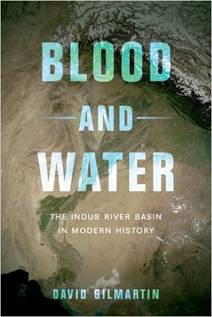 Abstract: The Indus basin was once an arid pastoral watershed, but by the second half of the twentieth century, it had become one of the world’s most heavily irrigated and populated river basins. Launched under British colonial rule in the nineteenth century, this irrigation project spurred political, social, and environmental transformations that continued after the 1947 creation of the new states of India and Pakistan. In this first large-scale environmental history of the region, David Gilmartin focuses on the changes that occurred in the basin as a result of the implementation of the world’s largest modern integrated irrigation system. This masterful work of scholarship explores how environmental transformation is tied to the creation of communities and nations, focusing on the intersection of politics, statecraft, and the environment. Abstract: The Indus basin was once an arid pastoral watershed, but by the second half of the twentieth century, it had become one of the world’s most heavily irrigated and populated river basins. Launched under British colonial rule in the nineteenth century, this irrigation project spurred political, social, and environmental transformations that continued after the 1947 creation of the new states of India and Pakistan. In this first large-scale environmental history of the region, David Gilmartin focuses on the changes that occurred in the basin as a result of the implementation of the world’s largest modern integrated irrigation system. This masterful work of scholarship explores how environmental transformation is tied to the creation of communities and nations, focusing on the intersection of politics, statecraft, and the environment. |
| 18. Carbon capitalism: energy, social reproduction and world order / Tim Di Muzio - London: Rowman & Littlefield, 2015 |
 Abstract: Modern civilization and the social reproduction of capitalism are bound inextricably with fossil fuel consumption. But as carbon energy resources become scarcer, what implications will this have for energy-intensive modes of life? Can renewable energy sustain high levels of accumulation?? Or will we witness the end of existing capitalist economies? This book provides an innovative and timely study that mobilizes a new theory of capitalism to explain the rise and fall of petro-market civilization. Di Muzio investigates how theorists of political economy have largely taken energy for granted and illuminates how the exploitation of fossil fuels increased the universalization and magnitude of capital accumulation. He then examines the likelihood of renewable resources providing a feasible alternative and asks whether they can beat peak oil prices to sustain food production, health care, science and democracy. Using the capital as power framework, this book considers the unevenly experienced consequences of monetizing fossil fuels for people and the planet. Abstract: Modern civilization and the social reproduction of capitalism are bound inextricably with fossil fuel consumption. But as carbon energy resources become scarcer, what implications will this have for energy-intensive modes of life? Can renewable energy sustain high levels of accumulation?? Or will we witness the end of existing capitalist economies? This book provides an innovative and timely study that mobilizes a new theory of capitalism to explain the rise and fall of petro-market civilization. Di Muzio investigates how theorists of political economy have largely taken energy for granted and illuminates how the exploitation of fossil fuels increased the universalization and magnitude of capital accumulation. He then examines the likelihood of renewable resources providing a feasible alternative and asks whether they can beat peak oil prices to sustain food production, health care, science and democracy. Using the capital as power framework, this book considers the unevenly experienced consequences of monetizing fossil fuels for people and the planet. |
| 19. Central ne win: apolitical biography / Robert H. Taylor - Singapore: ISEAS, 2015 |
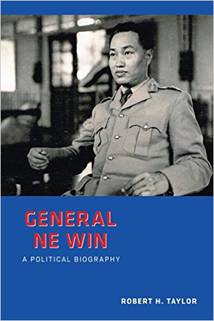 Abstract: Robert Taylor, one of the most prominent scholars in Myanmar studies, has written an illuminating study of Ne Win, the most enigmatic and controversial of the first generation of post-independence Southeast Asian leaders, and how he steered a then largely unknown country, Burma (now Myanmar), through the Cold War years. This book, by perhaps the only foreign political analyst to live in Burma under Ne Win, is a significant contribution to the historiography of Myanmar and its unnoticed role in the Cold War in Asia." --Associate Professor Ang Cheng Guan, Head of Graduate Studies, S. Rajaratnam School of International Studies, Nanyang Technological University, Singapore. Abstract: Robert Taylor, one of the most prominent scholars in Myanmar studies, has written an illuminating study of Ne Win, the most enigmatic and controversial of the first generation of post-independence Southeast Asian leaders, and how he steered a then largely unknown country, Burma (now Myanmar), through the Cold War years. This book, by perhaps the only foreign political analyst to live in Burma under Ne Win, is a significant contribution to the historiography of Myanmar and its unnoticed role in the Cold War in Asia." --Associate Professor Ang Cheng Guan, Head of Graduate Studies, S. Rajaratnam School of International Studies, Nanyang Technological University, Singapore. |
| 20. China and ASEAN: energy security, cooperation and competition / Zhao Hong Singapore: ISEAS, 2015 |
 Abstract: This book examines the energy resource relations between China and ASEAN countries. It addresses The following issues: as the world energy demand shifts East because of the rise of China, ASEAN community and other emerging Asian economies, and as the Greater Indian Ocean and the South China Sea the world's energy interstates, will geopolitical tensions over energy resources spark conflicts in the region especially in the China Sea? Against the background of China's rise and its growing influence in Southeast Asia, will China's quest for energy resource cooperation be viewed as a threat or opportunity by its neighboring countries? Since the United States, Japan and India are important players in Southeast Asia, does the shifting geopolitics of energy give these big powers a new strategic tool in an intensifying rivalry with China? Abstract: This book examines the energy resource relations between China and ASEAN countries. It addresses The following issues: as the world energy demand shifts East because of the rise of China, ASEAN community and other emerging Asian economies, and as the Greater Indian Ocean and the South China Sea the world's energy interstates, will geopolitical tensions over energy resources spark conflicts in the region especially in the China Sea? Against the background of China's rise and its growing influence in Southeast Asia, will China's quest for energy resource cooperation be viewed as a threat or opportunity by its neighboring countries? Since the United States, Japan and India are important players in Southeast Asia, does the shifting geopolitics of energy give these big powers a new strategic tool in an intensifying rivalry with China? |
| 21. China and the twenty-first-century crisis / Minqi Li - London: Pluto Press, 2016 |
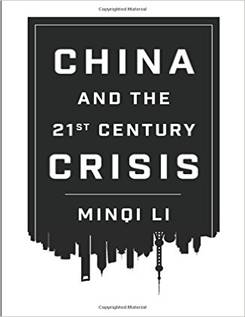 Abstract: Most discussions of the global financial crisis take the United States as their focus, both for analyzing what went wrong and for making plans to avoid similar mistakes in the future. But that may not be the case next time: as Minq Li argues convincingly in China and the Twenty-first-Century Crisis, by the time of inevitable next crisis, China will likely be at the epicenter. Abstract: Most discussions of the global financial crisis take the United States as their focus, both for analyzing what went wrong and for making plans to avoid similar mistakes in the future. But that may not be the case next time: as Minq Li argues convincingly in China and the Twenty-first-Century Crisis, by the time of inevitable next crisis, China will likely be at the epicenter. |
| 22. The China boom: why China will not rule the world / Ho-fung Hung - New York: Columbia University Press, 2016 |
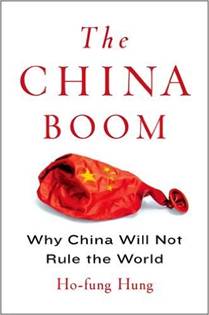 Abstract: Many thought China's rise would fundamentally remake the global order. Yet, much like other developing nations, the Chinese state now finds itself in a status quo characterized by free trade and American domination. Through a cutting-edge historical, sociological, and political analysis, Ho-fung Hung details the competing interests and economic realities that temper the dream of Chinese supremacy?forces that are stymieing growth throughout the global South. Abstract: Many thought China's rise would fundamentally remake the global order. Yet, much like other developing nations, the Chinese state now finds itself in a status quo characterized by free trade and American domination. Through a cutting-edge historical, sociological, and political analysis, Ho-fung Hung details the competing interests and economic realities that temper the dream of Chinese supremacy?forces that are stymieing growth throughout the global South. |
| 23. The China challenge: shaping the choices of a rising power / Thomas J. Christensen – New York: W Norton & Company, 2015 |
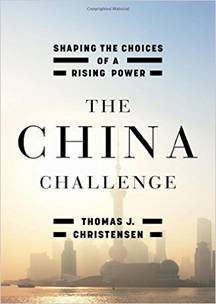 Abstract: The China Challenge shows why China is nowhere near powerful enough to be considered a global“peer competitor” of the United States, but it is already strong enough to destabilize East Asia and to influence economic and political affairs worldwide. Despite impressive achievements, the Chinese Communist Party faces enormous challenges. Christensen shows how nationalism and the threat of domestic instability influence the party’s decisions on issues like maritime sovereignty disputes, global financial management, of the Internet, climate change, and policies toward Taiwan and Hong Kong. Abstract: The China Challenge shows why China is nowhere near powerful enough to be considered a global“peer competitor” of the United States, but it is already strong enough to destabilize East Asia and to influence economic and political affairs worldwide. Despite impressive achievements, the Chinese Communist Party faces enormous challenges. Christensen shows how nationalism and the threat of domestic instability influence the party’s decisions on issues like maritime sovereignty disputes, global financial management, of the Internet, climate change, and policies toward Taiwan and Hong Kong. |
| 24. Code of conduct for outer space: a strategy for India / Manpreet Sethi - New Delhi: KW Publishers, 2016 |
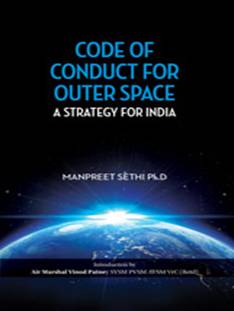 Abstract: Space has often been cited as a global commons and heritage of mankind. These are noble sentiments but belie reality. In fact, although the phrase ‘militarization of space’ gained currency somewhat later, the concept of military use of space was implicit from the day that the then USSR launched the Sputnik in 1957.The potential of ‘high ground’ was brought home in telling fashion and within a few weeks, a then highly National Reconnaissance Organization was created in the USA. The battle for the high ground and its exploitation had been well and truly joined. The jousting for superiority in space followed with increasing vigour. As more and more countries became space-faring nations or would-be space powers, there was a need for regulations to be adopted. This became even more important as the commercial exploitation of space was soon recognized. Abstract: Space has often been cited as a global commons and heritage of mankind. These are noble sentiments but belie reality. In fact, although the phrase ‘militarization of space’ gained currency somewhat later, the concept of military use of space was implicit from the day that the then USSR launched the Sputnik in 1957.The potential of ‘high ground’ was brought home in telling fashion and within a few weeks, a then highly National Reconnaissance Organization was created in the USA. The battle for the high ground and its exploitation had been well and truly joined. The jousting for superiority in space followed with increasing vigour. As more and more countries became space-faring nations or would-be space powers, there was a need for regulations to be adopted. This became even more important as the commercial exploitation of space was soon recognized. |
| 25. Cold war in South Asia: Britain, the United States and the Indian subcontinent 1945-1965 /Paul M. Mcgarr - Cambridge: Cambridge University Press, 2016 |
 Abstract: The Cold War in South Asia provides the first comprehensive and transnational history of Anglo-American relations with South Asia during a seminal period in the history of the Indian Subcontinent, between independence in the late 1940s, and the height of the Cold War in the late 1960s. Drawing upon significant new evidence from British, American Indian and Eastern bloc archives, the book re-examines how and why the Cold War in South Asia evolved in the way that it did, at a time when the national leaderships, geopolitical outlooks and regional aspirations of India, Pakistan and their superpower suitors were in a state of considerable flux. The book probes the factors which encouraged the governments of Britain and the United States to work so closely together in South Asia during the two decades after independence, and suggests what benefits, if any, Anglo-American intervention in South Asia's affairs delivered, and to whom. Abstract: The Cold War in South Asia provides the first comprehensive and transnational history of Anglo-American relations with South Asia during a seminal period in the history of the Indian Subcontinent, between independence in the late 1940s, and the height of the Cold War in the late 1960s. Drawing upon significant new evidence from British, American Indian and Eastern bloc archives, the book re-examines how and why the Cold War in South Asia evolved in the way that it did, at a time when the national leaderships, geopolitical outlooks and regional aspirations of India, Pakistan and their superpower suitors were in a state of considerable flux. The book probes the factors which encouraged the governments of Britain and the United States to work so closely together in South Asia during the two decades after independence, and suggests what benefits, if any, Anglo-American intervention in South Asia's affairs delivered, and to whom. |
| 26. Connecting South Asia and Southeast Asia - Japan: Asian Development Bank Institute, 2015. |
 Abstract: This report analyzes how closer regional connectivity and economic integration between South Asia and Southeast Asia can benefit both regions, with a focus on the role played by infrastructure and public policies in facilitating this process. It examines major developments in South Asian-Southeast Asian trade and investment, economic cooperation, the role of economic corridors, and regional cooperation initiatives. In particular, it identifies significant opportunities for strengthening these integration efforts as a result of the recent opening up of Myanmar in political, economic, and financial terms. This is particularly the case for land-based transportation-highways and railroads-and energy trading. The report's focus is on connectivity in a broad sense, covering both hardware and software, including investment in infrastructure, energy trading, facilitation investment financing, and support for national and regional policies. Abstract: This report analyzes how closer regional connectivity and economic integration between South Asia and Southeast Asia can benefit both regions, with a focus on the role played by infrastructure and public policies in facilitating this process. It examines major developments in South Asian-Southeast Asian trade and investment, economic cooperation, the role of economic corridors, and regional cooperation initiatives. In particular, it identifies significant opportunities for strengthening these integration efforts as a result of the recent opening up of Myanmar in political, economic, and financial terms. This is particularly the case for land-based transportation-highways and railroads-and energy trading. The report's focus is on connectivity in a broad sense, covering both hardware and software, including investment in infrastructure, energy trading, facilitation investment financing, and support for national and regional policies. |
| 27. The Courage to act: a memoir of crisis and its aftermath / Ben S. Bernanke - London: W.W Norton & Company, 2015 |
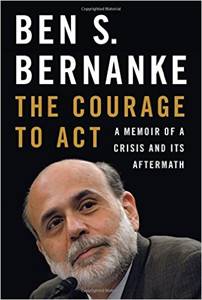 Abstract: In 2006, Ben S. Bernanke was appointed chair of the Federal Reserve, capping a meteoric trajectory from a rural South Carolina childhood to professorships at Stanford and Princeton, to public service in Washington's halls of power. There would be no time to celebrate, however-the burst of the housing bubble in 2007 set off a domino effect that would bring the global financial system to the brink of meltdown. In The Courage to Act, Ben Bernanke pulls back the curtain on the tireless and ultimately successful efforts to prevent a mass economic failure. Working with two U.S. presidents and two Treasury secretaries, Dr. Bernanke and his colleagues used every Fed capability, no matter how arcane, to keep the U.S. economy afloat. From his arrival in Washington in 2002 and his experiences before the crisis, to the intense days and weeks of the crisis itself, and through the Great Recession that followed, Dr. Bernanke gives readers an unequaled perspective on the American economy. This narrative will reveal for the first time how the creativity and decisiveness of a few key leaders prevented an economic collapse of unimaginable scale. Abstract: In 2006, Ben S. Bernanke was appointed chair of the Federal Reserve, capping a meteoric trajectory from a rural South Carolina childhood to professorships at Stanford and Princeton, to public service in Washington's halls of power. There would be no time to celebrate, however-the burst of the housing bubble in 2007 set off a domino effect that would bring the global financial system to the brink of meltdown. In The Courage to Act, Ben Bernanke pulls back the curtain on the tireless and ultimately successful efforts to prevent a mass economic failure. Working with two U.S. presidents and two Treasury secretaries, Dr. Bernanke and his colleagues used every Fed capability, no matter how arcane, to keep the U.S. economy afloat. From his arrival in Washington in 2002 and his experiences before the crisis, to the intense days and weeks of the crisis itself, and through the Great Recession that followed, Dr. Bernanke gives readers an unequaled perspective on the American economy. This narrative will reveal for the first time how the creativity and decisiveness of a few key leaders prevented an economic collapse of unimaginable scale. |
| 28. The Dao of World Politics: towards a post-Westphalian, woldist international relations / L. H. M. Ling - London: Routledge, 2014 |
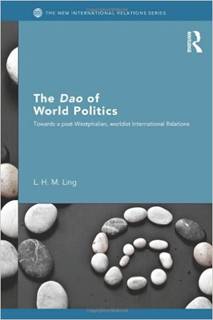 Abstract: This book draws on Daoist yin/yang dialectics to move world politics from the current stasis of hegemony, hierarchy, and violence to a more balanced engagement with parity, fluidity, and ethics. The author theorizes that we may develop a richer, more representative approach towards sustainable and democratic governance by offering a non-Western alternative to hegemonic debates in IR. The book presents the story of world politics by integrating folk tales and popular culture with policy analysis. It does not exclude current models of liberal internationalism but rather brackets them for another day, another purpose. The deconstruction of IR as a singular unifying school of thought through the lens of a non-Westphalian analytic shows a unique perspective on the forces that drive and shape world politics. This book suggests new ways to articulate and act so that global politics is more inclusive and less coercive. Abstract: This book draws on Daoist yin/yang dialectics to move world politics from the current stasis of hegemony, hierarchy, and violence to a more balanced engagement with parity, fluidity, and ethics. The author theorizes that we may develop a richer, more representative approach towards sustainable and democratic governance by offering a non-Western alternative to hegemonic debates in IR. The book presents the story of world politics by integrating folk tales and popular culture with policy analysis. It does not exclude current models of liberal internationalism but rather brackets them for another day, another purpose. The deconstruction of IR as a singular unifying school of thought through the lens of a non-Westphalian analytic shows a unique perspective on the forces that drive and shape world politics. This book suggests new ways to articulate and act so that global politics is more inclusive and less coercive. |
| 29. Delhi dialogue VII ASEAN-INDIA: shaping the post-2015 agenda / Edited Rumel Dhaiya New Delhi: Pentagoon Press, 2015 |
 Abstract: This volume is based on the proceedings of Delhi Dialogue VII held in March 2015. It epitomizes the growing dialogue between India and ASEAN at all levels. Delhi Dialogue brings together practitioners, corporate leaders, opinion makers, academics and journalists, every year, to discuss a wide range of issues of common interest and concern that animate the India - ASEAN relationship. Discussions held at the Delhi Dialogue, subsequent to ASEAN Commemorative Summit issuing the ‘Vision Statement’ in 2012, provide a good insight into the likely scenarios and possible trends in the post-2015 era. Abstract: This volume is based on the proceedings of Delhi Dialogue VII held in March 2015. It epitomizes the growing dialogue between India and ASEAN at all levels. Delhi Dialogue brings together practitioners, corporate leaders, opinion makers, academics and journalists, every year, to discuss a wide range of issues of common interest and concern that animate the India - ASEAN relationship. Discussions held at the Delhi Dialogue, subsequent to ASEAN Commemorative Summit issuing the ‘Vision Statement’ in 2012, provide a good insight into the likely scenarios and possible trends in the post-2015 era. |
| 30. Diasporas and foreign direct investment in China and India / Min Ye - Cambridge: Cambridge University Press, 2014 |
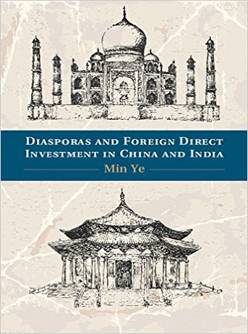 Abstract: This book offers a comparative and historical analysis of foreign direct investment (FDI) liberalization in China and India and explains how the return of these countries' affects such liberalization. It examines diasporic investment from Western FDIs and finds that diasporas, rather than Western nations, have fueled globalization in the two Asian giants. In China, diasporas contributed the lion's share of FDI inflows. In India, returned diasporas were bridges for, and initiators of, Western investment at home. Min Ye illustrates that diasporas entrepreneurs helped to build China into the world's manufacturing powerhouse and that diasporas facilitated their homeland's success in software services development. Abstract: This book offers a comparative and historical analysis of foreign direct investment (FDI) liberalization in China and India and explains how the return of these countries' affects such liberalization. It examines diasporic investment from Western FDIs and finds that diasporas, rather than Western nations, have fueled globalization in the two Asian giants. In China, diasporas contributed the lion's share of FDI inflows. In India, returned diasporas were bridges for, and initiators of, Western investment at home. Min Ye illustrates that diasporas entrepreneurs helped to build China into the world's manufacturing powerhouse and that diasporas facilitated their homeland's success in software services development. |
| 31. Diplomatic dimension of maritime challenges for India in the 21st century / Yogendra Kumar – New Delhi: Pentagon Press, 2015 |
 Abstract: The ebbs and flows of Indian history can also be charted through the country’s “maritime blindness” – its onset and the national endeavour to overcome it. The story of developing India’s maritime capacity, since independence, is also about the kind of international and regional footprint it needs to have. In this book, the author discusses India’s new and old maritime challenges and contextualises them in terms of its inherent institutional strengths to cope with their bewildering complexity. Their complexity is not just due to their sheer scale; the degrading institutional capacities, within countries and internationally, act as threat multipliers. The dynamics of global geopolitics, the seismic perturbations of global economy, and the dizzying pace of technology belie presuppositions for global future; all strategic analysts recognise our current, persisting conundrums. Abstract: The ebbs and flows of Indian history can also be charted through the country’s “maritime blindness” – its onset and the national endeavour to overcome it. The story of developing India’s maritime capacity, since independence, is also about the kind of international and regional footprint it needs to have. In this book, the author discusses India’s new and old maritime challenges and contextualises them in terms of its inherent institutional strengths to cope with their bewildering complexity. Their complexity is not just due to their sheer scale; the degrading institutional capacities, within countries and internationally, act as threat multipliers. The dynamics of global geopolitics, the seismic perturbations of global economy, and the dizzying pace of technology belie presuppositions for global future; all strategic analysts recognise our current, persisting conundrums. |
| 32. Does India think strategically?: Institutions, strategic culture and security policies / Edited by Happymon Jacob- New Delhi: Manohar, 2014 |
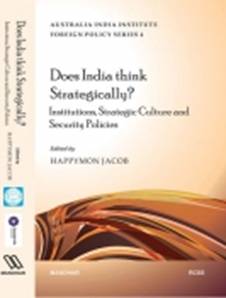 Abstract: The book addresses two major questions: whether India has a strategic culture which informs the country’s foreign, defence and security thinking and whether India’s foreign and security policies are based on a coherent strategic thinking. The volume, in other words, explores India’s strategic culture, which shapes the country’s strategic thought. From theories of grand strategy to critical constructivist interpretations, a whole range of approaches to this question are included. With its current rapid economic growth, demand for a permanent UNSC seat, successful alliance building (e.g. BRICS, Indo-US strategic partnership), and desire to play a greater role in global affairs, India’s growing stature requires further analysis on how and why Indian policies are carried out. This book examines the various influences on Indian strategic culture. It will act as guide to those who wish to see patterns in Indian strategic thinking/planning and serve to explain the background of Indian foreign policies. This book is being produced two decades after the end of the Cold War, which had a major impact on international politics. Therefore, it allows for analysis of Indian strategic culture/thinking both during the Cold War and the changes it experienced after its end. A consolidated collection of academic opinions on India’s strategic culture and thinking, especially from an Indian perspective, will greatly contribute to the field of international relations given India’s rising importance in the global order. Abstract: The book addresses two major questions: whether India has a strategic culture which informs the country’s foreign, defence and security thinking and whether India’s foreign and security policies are based on a coherent strategic thinking. The volume, in other words, explores India’s strategic culture, which shapes the country’s strategic thought. From theories of grand strategy to critical constructivist interpretations, a whole range of approaches to this question are included. With its current rapid economic growth, demand for a permanent UNSC seat, successful alliance building (e.g. BRICS, Indo-US strategic partnership), and desire to play a greater role in global affairs, India’s growing stature requires further analysis on how and why Indian policies are carried out. This book examines the various influences on Indian strategic culture. It will act as guide to those who wish to see patterns in Indian strategic thinking/planning and serve to explain the background of Indian foreign policies. This book is being produced two decades after the end of the Cold War, which had a major impact on international politics. Therefore, it allows for analysis of Indian strategic culture/thinking both during the Cold War and the changes it experienced after its end. A consolidated collection of academic opinions on India’s strategic culture and thinking, especially from an Indian perspective, will greatly contribute to the field of international relations given India’s rising importance in the global order. |
| 33. An economist in the real world: the art of policymaking in India / Kaushik Basu – London: The MIT Press, 2015 |
 Abstract: In December 2009, the economist Kaushik Basu left the rarefied world of academic research for the nuts and bolts of policymaking. Appointed by the then Prime Minister of India, Manmohan Singh, to be chief economic adviser (CEA) to the Government of India, Basu – a theorist, with special interest in development economics, and a professor of economics at Cornell University -- discovered the complexity of applying economic models to the real world. Effective policymaking, Basu learned, integrates technical knowledge with political awareness. In this book, Basu describes the art of economic policymaking, viewed through the lens of his two and a half years as CEA. Basu writes from a unique perspective -- neither that of the career bureaucrat nor that of the traditional researcher. Abstract: In December 2009, the economist Kaushik Basu left the rarefied world of academic research for the nuts and bolts of policymaking. Appointed by the then Prime Minister of India, Manmohan Singh, to be chief economic adviser (CEA) to the Government of India, Basu – a theorist, with special interest in development economics, and a professor of economics at Cornell University -- discovered the complexity of applying economic models to the real world. Effective policymaking, Basu learned, integrates technical knowledge with political awareness. In this book, Basu describes the art of economic policymaking, viewed through the lens of his two and a half years as CEA. Basu writes from a unique perspective -- neither that of the career bureaucrat nor that of the traditional researcher. |
| 34. The Economy of Bangladesh: a quarter century of development / Azizur Rahman Khan New York: Palgrave Macmillan, 2015 |
 Abstract: This book identifies the factors behind the considerable success and continuing blemishes of Bangladesh's development experience. While the development community was bemused by Bangladesh's unexpected success in attaining high growth, and remarkable improvement in infant and child mortality, life expectancy, primary school enrolment and the status of women, it needs to be aware of the looming dangers to its ability to sustain improve upon its past performance. Abstract: This book identifies the factors behind the considerable success and continuing blemishes of Bangladesh's development experience. While the development community was bemused by Bangladesh's unexpected success in attaining high growth, and remarkable improvement in infant and child mortality, life expectancy, primary school enrolment and the status of women, it needs to be aware of the looming dangers to its ability to sustain improve upon its past performance. |
| 35. Elemental India: the natural world at a time of crisis and opportunity / Meera Subramanian - India: HarperCollins, 2015 |
 Abstract: Around the world, people are increasingly facing a future that is crowded and hot, thirsty or drowning, subject to violent weather extremes and a changing climate, where the and poor inhabit separate spheres and governments are unable or unwilling to confront the most vital challenges their citizens face. For India, this reality is the very tangible present. In this lyrical exploration of life, loss and survival, Meera Subramanian travels in search of the ordinary people and micro-enterprises that are determined to revive India's ravaged natural world. Abstract: Around the world, people are increasingly facing a future that is crowded and hot, thirsty or drowning, subject to violent weather extremes and a changing climate, where the and poor inhabit separate spheres and governments are unable or unwilling to confront the most vital challenges their citizens face. For India, this reality is the very tangible present. In this lyrical exploration of life, loss and survival, Meera Subramanian travels in search of the ordinary people and micro-enterprises that are determined to revive India's ravaged natural world. |
| 36. The European external action service and national foreign ministries: convergence or divergence? / Edited by Rosa Balfour - England: Ashgate, 2015 |
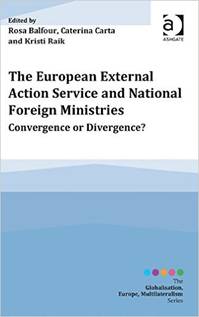 Abstract: Based on extensive empirical work by a cross-European group of researchers, this book assesses the impact of the creation of the European External Action Service (EEAS) on the national foreign policy-making processes and institutions of the EU member states. As such, the contributions cover both the involvement of the national diplomatic and foreign policy actors in shaping the outlook of the EEAS and its mission, as well as the changes (or not) it has produced for those actors of the member states. The analysis draws in theoretical frame works from Europeanization and socialization, but also from intergovernmental frameworks of policy-making within the European Union. Abstract: Based on extensive empirical work by a cross-European group of researchers, this book assesses the impact of the creation of the European External Action Service (EEAS) on the national foreign policy-making processes and institutions of the EU member states. As such, the contributions cover both the involvement of the national diplomatic and foreign policy actors in shaping the outlook of the EEAS and its mission, as well as the changes (or not) it has produced for those actors of the member states. The analysis draws in theoretical frame works from Europeanization and socialization, but also from intergovernmental frameworks of policy-making within the European Union. |
| 37. Foreign relations law / Campbell McLachlan - Cambridge: Cambridge University Press, 2014 |
 Abstract: What legal principles govern the external exercise of the public power of states within common law legal systems? Foreign Relations Law tackles three fundamental issues: the distribution of the foreign relations power between the organs of government; the impact of foreign relations power on individual rights; and the treatment of the foreign state within the legal system. Focusing on the four Anglo-Commonwealth states (the United Kingdom, Australia, and New Zealand) Abstract: What legal principles govern the external exercise of the public power of states within common law legal systems? Foreign Relations Law tackles three fundamental issues: the distribution of the foreign relations power between the organs of government; the impact of foreign relations power on individual rights; and the treatment of the foreign state within the legal system. Focusing on the four Anglo-Commonwealth states (the United Kingdom, Australia, and New Zealand) |
| 38. From deep state to Islamic state: the Arab counter-revolution and its Jihadi legacy / -Pierre Filiu – London: Hurst & Company, 2015 |
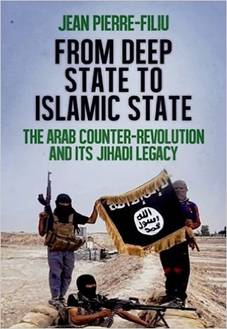 Abstract: The full potential of the Arab counter-revolution surprised most observers, who thought they had seen it all from the Arab despots: their perversity, their brutality, their voracity. But the wider world underestimated their ferocious readiness literally to burn down countries in order to cling to absolute power. Bashar al-Assad clambered to the top of this murderous class of tyrants, driving nearly half of the Syrian population in to exile and executing tens of thousands of his opponents. He has set a grisly precedent, one that other Arab autocrats are sure to follow in their pursuit of absolute power. Abstract: The full potential of the Arab counter-revolution surprised most observers, who thought they had seen it all from the Arab despots: their perversity, their brutality, their voracity. But the wider world underestimated their ferocious readiness literally to burn down countries in order to cling to absolute power. Bashar al-Assad clambered to the top of this murderous class of tyrants, driving nearly half of the Syrian population in to exile and executing tens of thousands of his opponents. He has set a grisly precedent, one that other Arab autocrats are sure to follow in their pursuit of absolute power. |
| 39. Global environmental constitutionalism / James R. May and Erin Daly - Cambridge: Cambridge University Press, 2015 |
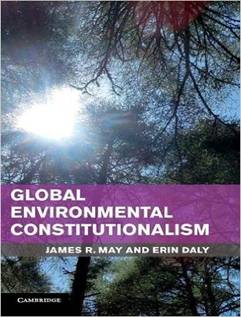 Abstract: Reflecting a global trend, scores of countries have affirmed that their citizens are entitled to healthy air, water, and land and that their constitution should guarantee certain environmental rights. This book examines the increasing recognition that the environment is a proper subject for protection in constitutional texts and for vindication by constitutional courts. This phenomenon, which the authors call environmental constitutionalism, represent the confluence of constitutional law, international law, human rights, and environmental law. Abstract: Reflecting a global trend, scores of countries have affirmed that their citizens are entitled to healthy air, water, and land and that their constitution should guarantee certain environmental rights. This book examines the increasing recognition that the environment is a proper subject for protection in constitutional texts and for vindication by constitutional courts. This phenomenon, which the authors call environmental constitutionalism, represent the confluence of constitutional law, international law, human rights, and environmental law. |
| 40. Handbook of Indian defence policy: themes, structures and doctrines / Edited by Harsh V. Pant London: Routledge, 2016 |
 Abstract: India has the world’s fourth largest military and one of the biggest defense budgets. It asserts its political and military profile in South Asia and the Indian Ocean region. The nation has been in the midst of an ambitious plan to modernize its largely Soviet-era arms since the late 1990s and has spent billions of dollars on latest high-tech military technology. Abstract: India has the world’s fourth largest military and one of the biggest defense budgets. It asserts its political and military profile in South Asia and the Indian Ocean region. The nation has been in the midst of an ambitious plan to modernize its largely Soviet-era arms since the late 1990s and has spent billions of dollars on latest high-tech military technology. |
| 41. The Image of the enemy: intelligence analysis of adversaries since 1945 / Edited by Paul Maddrell - Washington: Georgetown University Press, 2015 |
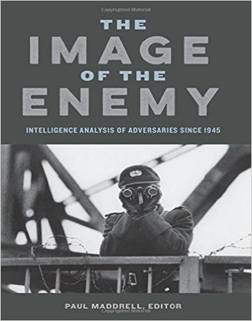 Abstract: Drawing on declassified documents, interviews with intelligence veterans and policymakers, and other sources, The Image of the Enemy breaks new ground as it examines how seven countries analyzed and used intelligence to shape their understanding of their main adversary. The cases in the book include the Soviet Union's of the United States (and vice versa), East Germany's analysis of West Germany (and vice versa), British in the early years of the in Northern Ireland, Israeli intelligence about the Palestinians, Pakistani intelligence on India, and US intelligence about Islamist terrorists. Abstract: Drawing on declassified documents, interviews with intelligence veterans and policymakers, and other sources, The Image of the Enemy breaks new ground as it examines how seven countries analyzed and used intelligence to shape their understanding of their main adversary. The cases in the book include the Soviet Union's of the United States (and vice versa), East Germany's analysis of West Germany (and vice versa), British in the early years of the in Northern Ireland, Israeli intelligence about the Palestinians, Pakistani intelligence on India, and US intelligence about Islamist terrorists. |
| 42. India and the contemporary international system: theory, policy and structure / Edited by Amitabh Mattoo and Happymon Jacob - New Delhi: Manohar, 2014 |
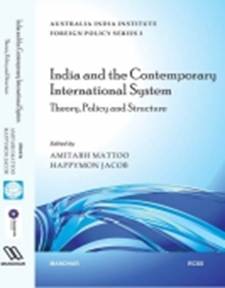 Abstract: New Directions in Indian Foreign Policy aims to explore Indian Foreign Policy since the end of the Cold War and investigate the latest trends in India’s foreign policy behavior. The book covers a whole range of issues including India’s nuclear identity, climate change, resource crunch, and diplomacy, India’s great power aspirations, and domestic influences on foreign policy making. Considering that the end of the Cold War is widely understood to be a game changer for Indian Foreign Policy, it is an opportune time to ask whether India has indeed embraced a new foreign policy. In other words, two decades since the end of the Cold War and the beginning of the economic liberalization process and the coalition politics in the country, what are the changes and continuities in the contemporary Indian Foreign Policy? Abstract: New Directions in Indian Foreign Policy aims to explore Indian Foreign Policy since the end of the Cold War and investigate the latest trends in India’s foreign policy behavior. The book covers a whole range of issues including India’s nuclear identity, climate change, resource crunch, and diplomacy, India’s great power aspirations, and domestic influences on foreign policy making. Considering that the end of the Cold War is widely understood to be a game changer for Indian Foreign Policy, it is an opportune time to ask whether India has indeed embraced a new foreign policy. In other words, two decades since the end of the Cold War and the beginning of the economic liberalization process and the coalition politics in the country, what are the changes and continuities in the contemporary Indian Foreign Policy? |
| 43. India-Australia relations in the Asian century: perspective from India and Australia / Edited by Amitabh Matto and Souresh Roy - New Delhi: Manohar, 2014 |
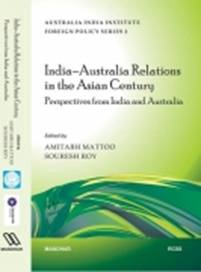 Abstract: As key strategic players and mid-level powers, Australia and India remain important countries in Asia Pacific region. Strong political, economic and security relations have developed between the two countries since the 1940s. Australia and India also share democratic values and have strong democratic institutions. The linkages between the two countries also extend to population migration, with Australia being home to a large Indian Diaspora. Abstract: As key strategic players and mid-level powers, Australia and India remain important countries in Asia Pacific region. Strong political, economic and security relations have developed between the two countries since the 1940s. Australia and India also share democratic values and have strong democratic institutions. The linkages between the two countries also extend to population migration, with Australia being home to a large Indian Diaspora. |
| 44. India's economic growth: opportunities and challenges for the regions / Edited by Mallika Joseph and Happynon Jacob - New Delhi: Manohar, 2014 |
 Abstract: Since adopting liberal economic policies two decades ago, India has become one of the two fastest growing economies in the world. While India has been reaching out to various regions such as Southeast Asia and the Middle East for expansion and strengthening linkages, India’s relations with its immediate South Asian neighbors remain problematic. India’s bilateral relations with the other regional countries have traditionally been contentious due to border issues as well as the fears and resistance of smaller countries to an Indian hegemony in the region. Abstract: Since adopting liberal economic policies two decades ago, India has become one of the two fastest growing economies in the world. While India has been reaching out to various regions such as Southeast Asia and the Middle East for expansion and strengthening linkages, India’s relations with its immediate South Asian neighbors remain problematic. India’s bilateral relations with the other regional countries have traditionally been contentious due to border issues as well as the fears and resistance of smaller countries to an Indian hegemony in the region. |
|